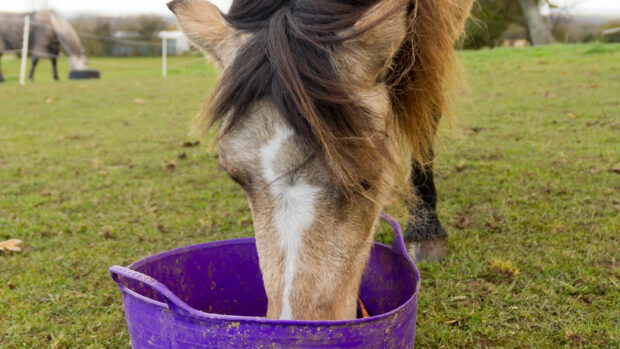As herbivores, it is natural for horses to seek out and eat herbs, such as comfrey, red clover, garlic, dandelion and nettle, which have healing properties in their seeds, flowers, roots, stems or leaves.
Feeding herbs requires common sense, patience and a degree of observation and monitoring – always consult your vet before offering aspecific herb as treatment for any condition.
Homeopathic vet Tim Couzens, who runs the Holistic Veterinary Medicine Centre near Lewes, in East Sussex, says that the appeal of herbs is as strong as ever, with his practice receiving an increasing number of referrals from traditional vets.
Although Tim says that certain herbs, such as garlic, remain ever popular, lesser-known ones, like monk’s pepper, are starting to be used more frequently.
“Monk’s pepper is useful for hormonal mares with PMT,” explains Tim, who is the veterinary advisor for Hilton Herbs. “It can smooth out fluctuations in hormones that cause a change in behaviour.”
Six commonly used herbs
Stinging nettle
Rich in vitamin C, iron, sodium, chlorophyll, protein and dietary fibre, nettles are a useful addition to feed if chopped and left to wilt, or – when made into a spring tonic – as a blood cleanser and conditioner to ward off skin ailments, such as sweet itch. The recommended daily dosage is 40-50g added to feed.
Boasting great eliminative properties through liver and kidney, the plant is beneficial in the absorption of iron, making it useful in the veterinary treatment of anaemia.
Nettles also help stimulate circulation, which is useful in cases of laminitis, rheumatism and arthritis.
Occasionally, the plant may cause urticaria, an allergic skin rash resembling welts, even when taken internally, so it is best avoided if a reaction occurs.
Comfrey
Horses usually relish the taste of this versatile herb. Comfreyhas a reputation for healing bone damage, such as sore shins, chipped knees, stress fractures (about 40 leaves of white comfrey and at least one cleaned root a day is recommended) and arthritis (three large leaves of pink comfrey a day), as wellas tendon strains.
Comfrey’s healing qualities also extend to repairing damage to lungs and the respiratory system when a horse ‘bleeds’ or ‘bursts’.
Recently, there has been a suggestion that it can produce liver damage if large quantities are fed over long periods.
Dandelion
Dandelions are a good source of potassium, calcium, iron and beta-carotene. Efficient at relieving oedema, the herb can also aid kidney and liver complaints, including jaundice, and it can stimulate appetite and boost digestion.
As well as being a mild laxative, this plant is also used to cleanse the blood of impurities, and for rheumatism, arthritis and laminitis. All parts of the plant are safe and effective to use.
Garlic
Garlic is one of the most popular herbs, whose most common uses are repelling flies, relieving sweet itch symptoms, aiding digestion, preventing coughs and worms and maintaining all-round good health, as it is an excellent antioxidant.
Garlic is rich in vitamin C, thiamine and potassium, and also contains sulphur, whichis a recognised blood cleanser.
This bulb helps to reduce blood pressure in excitable horses and those competing, and has a positive effect on respiratory disorders.
A good winter-warming remedy, garlic can be fed as a pure herb or in powder, oil, granulated or shredded form. As a general additive, two cloves of garlic can be put in your horse’s feed daily. For those suffering from a viral infection, feed four cloves per day.
Valerian
The root is used in herbal preparations as a sedative to relieve nervous tension – such as when a horse arrives at a new yard – or to calm over-excitable horses, without affecting performance.
Valerian combines extremely well with other relaxing herbs, such as chamomile and hops, to make a general calming blend, and can be helpful in settling the digestive system.
It is also said to be a good treatment for cramps, colic, bronchial spasm, flatulence, nervous exhaustion and cases of constipation.
Although valerian is a non-addictive herb without side effects, it is a natural tranquiliser and can cause drowsiness, so you should always consult your vet before using it. It is also a banned substance under competition rules.
Meadowsweet
Meadowsweet contains an aspirin-like compound and has valuable anti-inflammatory properties. Itis good for gut problems and joint pain, as well as for treating arthritis in the lower limbs.
When combined with other herbs, such as devil’s claw, prickly ash bark and hawthorn – which helps open up the peripheral circulation – meadowsweetcan be beneficial in treating chronic laminitis cases.
It can also be used to help heal ulcers, reduce fever, it aids bladder and kidney disorders. Herbalists use the whole plant – which can grow up to six feet in height – including the roots.
| The complete article can be found in the NEW LOOK June issue of HORSE magazine, available in your newsagent from 1 May.
Click here to subscribe to HORSE magazine, which is packed with fantastic features every month, including two new regular sections: Practical Horse (riding and training advice) and Kit (all the latest products). |



